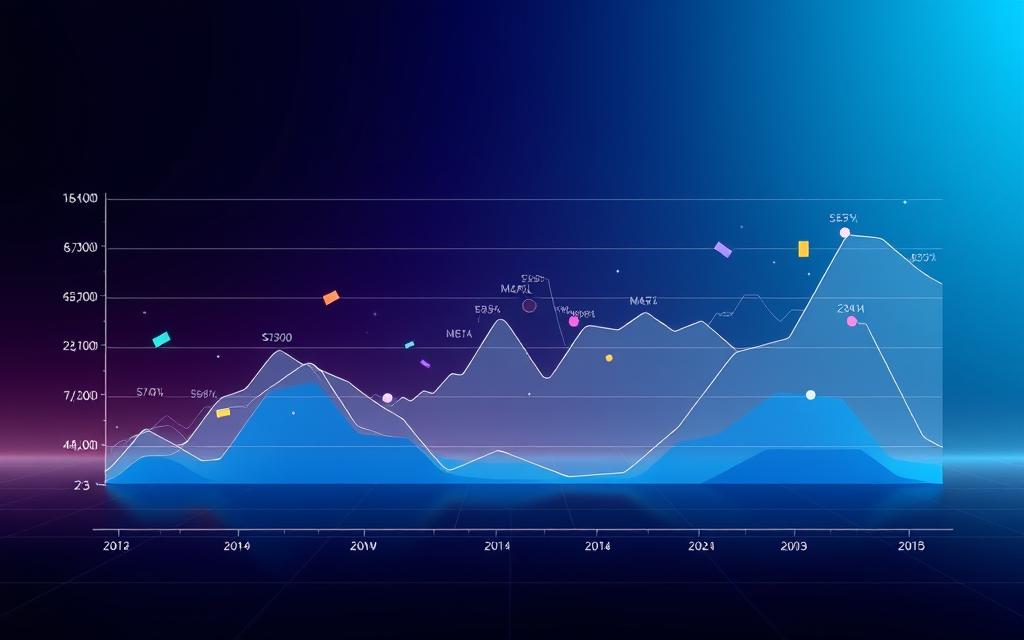Table of Contents
Cryptocurrency market capitalization measures the total value of a digital asset. It combines current price and circulating supply to show a project’s overall worth. This metric helps investors compare different blockchain projects at a glance.
Market capitalization reveals a coin’s dominance and stability. Larger-cap assets like Bitcoin often show lower volatility, while smaller altcoins may offer higher growth potential. Tools like CoinMarketCap track these figures in real time.
Unlike traditional stocks, digital currencies use unique valuation methods. Liquidity and adoption play key roles in determining long-term success. For deeper insights, explore how market cap influences crypto investments.
What Is Crypto Market Cap?
Investors rely on market cap to gauge a token’s relative size and influence. This metric combines an asset’s current price with its circulating supply, offering a clear picture of its total valuation.
Definition and Basic Concept
Market Cap = Price × Circulating Supply
For example, if Bitcoin trades at $50,000 with 19 million coins in circulation, its market cap would be $950 billion. Unlike total supply, circulating supply excludes locked or reserved tokens, like XRP’s 1 billion held in escrow.
How It Differs from Traditional Market Cap
Stocks calculate valuation using outstanding shares, but digital assets prioritize circulating supply. Ethereum’s 2020 supply confusion showed how inflated numbers can distort market cap. Tokens like Tether (a stablecoin) also skew comparisons, as their value stems from utility, not scarcity.
In traditional markets, a company’s currency valuation reflects earnings and assets. Blockchain projects, however, derive worth from adoption and liquidity—factors not captured by raw numbers alone.
How Is Crypto Market Cap Calculated?
Calculating a token’s worth requires multiplying its price by available tokens. This simple equation reveals the project’s total valuation, but nuances like supply metrics demand closer scrutiny.
The Formula: Price × Circulating Supply
Market capitalization derives from two variables: the current price and the number coins actively traded. For instance, a $100 altcoin with 25 million in circulation would have a $2.5 billion valuation.
Market Cap = Current Price × Circulating Supply

Why Circulating Supply Matters
Unlike total supply, which includes locked or reserved tokens, coins circulation reflects actively tradable units. Bitcoin’s 21 million hard cap contrasts with XRP’s escrowed 1 billion, showing why maximum supply can mislead.
Projects with uncapped issuance (e.g., some stablecoins) further complicate comparisons. Always verify whether trackers exclude staked or burned tokens to avoid inflated figures.
Tools to Track Market Cap
Platforms like CoinMarketCap aggregate data across 500+ exchanges, using volume-weighted averages for accuracy. Their real-time dashboards help investors spot trends while filtering outliers.
However, inconsistencies exist—some tokens report outdated total number metrics. Cross-reference multiple sources to confirm circulating figures before making decisions.
Why Crypto Market Cap Matters
Understanding a digital asset’s true scale requires more than just price analysis. Valuation tiers reveal stability, growth potential, and hidden risks—critical for strategic investment decisions.
Indicator of Size and Stability
Large-cap tokens like Bitcoin and Ethereum often anchor portfolios with lower volatility. During 2021’s downturns, Bitcoin dipped 40% while smaller assets plummeted 90%. This metric helps identify resilient projects.
Mid-range assets ($1B–$10B), such as Avalanche, balance risk and innovation. Their moderate caps attract growth-focused traders without the extremes of micro-cap speculation.
Role in Investment Decisions
Market cap acts as a quick filter for portfolio diversification. High liquidity in tokens like Binance Coin—with $1B daily trades—ensures easier exits during swings. Investment decisions improve when combined with volume analysis.
Limitations of Relying Solely on Market Cap
FTX Token’s collapse exposed artificial scarcity traps—its inflated cap hid low circulating supply. Similarly, Tether’s $83B valuation reflects utility, not scarcity, unlike Bitcoin’s adoption-driven worth.
“Market cap is a snapshot, not a prophecy. Always cross-check with trading volume and tokenomics.”
This metric also ignores short-term volume spikes. Savvy traders pair it with on-chain data to spot discrepancies.
Categories of Cryptocurrencies by Market Cap
Token valuations span a wide spectrum, from stable giants to volatile newcomers. Classifying assets by their total worth helps investors balance portfolios and manage risk. Three primary segments dominate: large-cap, mid-cap, and small-cap tokens, each with distinct traits.

Large-Cap Cryptocurrencies: Safety and Liquidity
Bitcoin ($580B valuation) exemplifies large-cap cryptocurrencies, often called “blue chips.” Its institutional adoption and liquidity make it a cornerstone for conservative portfolios. Ethereum follows closely, with smart contract utility driving its dominance.
These assets typically weather downturns better. During the 2022 crash, Bitcoin lost 40% versus 90% drops for smaller tokens.
Mid-Cap Cryptocurrencies: Growth Potential
Mid-cap cryptocurrencies like Avalanche ($12B) offer a sweet spot—established yet innovative. Avalanche competes with Ethereum in smart contracts, attracting developers without Bitcoin’s price ceiling.
Dogecoin ($10B) highlights contrasts: its meme-driven valuation lacks Polkadot’s tech focus, yet both sit in this tier. Research fundamentals to separate hype from substance.
Small-Cap Cryptocurrencies: High Risk, High Reward
Projects like Fantom and Dash represent small-cap cryptocurrencies, where 200% annualized gains tempt traders. However, Terra’s $40B collapse underscores the peril—artificial demand can vanish overnight.
“Small-caps are rockets or rubble. Never allocate more than 10% of your portfolio.”
| Category | Avg. Annual Return | Volatility |
|---|---|---|
| Large-Cap | 70% | Low |
| Mid-Cap | 120% | Moderate |
| Small-Cap | 200% | Extreme |
How to Use Market Cap in Your Crypto Strategy
Strategic investors leverage valuation metrics to optimize their digital asset portfolios. By analyzing cap tiers, traders can align holdings with their risk tolerance and financial goals. This approach transforms raw data into actionable insights.

Balancing Risk and Reward
Allocate assets across cap tiers to mitigate volatility. Backtested models suggest:
- 50% large-cap (Bitcoin, Ethereum): Stability anchors
- 30% mid-cap (Avalanche, Polkadot): Growth catalysts
- 20% small-cap (Fantom, Dash): High-reward gambits
Bitcoin Cash’s $4B cap misleads newcomers—its higher price doesn’t reflect XRP’s $25B dominance. Always prioritize circulating supply over per-unit cost.
Combining Market Cap with Other Metrics
Pair cap with Fully Diluted Valuation (FDV) to spot overvaluations. Solana’s 2021 surge showed inflated FDV ratios, signaling a correction. CoinMarketCap’s filters help cross-reference:
- Daily trading volume
- Sector trends (DeFi, NFTs)
- Stablecoin ratios (e.g., USDT’s $83B cap as a liquidity gauge)
Examples of Market Cap in Action
During the 2022 crash, large-cap tokens lost 40% versus 90% drops for small caps. Hedging with stablecoins (like USDC) preserved capital while maintaining exposure.
“Cap tiers are compasses, not maps. Pair them with on-chain activity for true navigation.”
Tools like TradingView overlay cap trends with volume spikes, revealing hidden opportunities in crypto assets.
Conclusion
Smart traders know market cap alone doesn’t tell the full story. While it ranks assets by value, combining it with on-chain data—like exchange flows or whale movements—reveals deeper trends.
Avoid “cap chasing.” Projects with inflated valuations often hide low liquidity. Tools like CoinGecko provide real-time metrics, but investment decisions demand broader analysis.
In cryptocurrency, hierarchy exists, but DYOR remains key. Market cap guides—it doesn’t guarantee.
FAQ
How is cryptocurrency market capitalization calculated?
It’s determined by multiplying the current price of a digital asset by its circulating supply. This metric helps gauge the total value of a coin or token in the market.
Why does circulating supply matter in valuation?
Unlike total supply, circulating supply represents coins actively traded. This distinction prevents inflated valuations from locked or reserved tokens that aren’t liquid.
What’s the difference between large-cap and small-cap cryptocurrencies?
Large-cap assets like Bitcoin offer stability, while small-cap tokens present higher growth potential but carry greater volatility and risk.
Where can investors track real-time market cap data?
Platforms like CoinMarketCap and CoinGecko provide updated metrics, including price movements, trading volume, and circulating supply figures.
How should traders use this metric in portfolio strategy?
Savvy investors balance large-cap stability with mid-cap growth opportunities while limiting exposure to high-risk small-cap assets.
What are the limitations of relying solely on this valuation method?
It doesn’t account for token utility, project fundamentals, or network effects – investors should combine it with technical and fundamental analysis.









